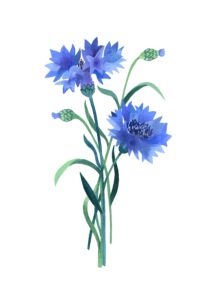 Domestication and Freedom “In a Dawn of Cornflowers”
Domestication and Freedom “In a Dawn of Cornflowers”
By Ciara O’Donoghue (’23)
Cornflowers feature in some of Sylvia Plath’s most well-known work, and understanding the plant can help us to understand Plath. Much like Plath, the plant is dichotomous, living as both a beloved garden flower and pesky weed. It is domesticated and yet wild, inhabiting two positions at once. This dual identity is not to be resolved, but understood as parts of a whole. Famously, Plath also wanted to be understood and accepted as multiple things at once. She resisted the limitations of traditional femininity, but did not reject its aesthetics and pleasures. She shunned it and embraced it. She found herself engaged in battle with these two halves of her identity and, in some ways, failed to reconcile them. Plath wanted to be free of the oppressive forms of femininity in order to achieve her dream of being both a writer and mother. What does society do with those prescribed to be domesticated, but who resist the confines of the garden? Let’s consider the cornflower.
Cornflowers are known for their vibrant color—”cornflower blue”—a well-established color in the cultural imagination. Cornflower blue is a shade of medium to light blue containing very little green pigment. The blue color is produced by an anthocyanin pigment called protocyanin. This particular shade was a favorite of the Dutch master painter Johannes Vermeer. The most prized sapphires with a medium violet-blue tone are designated as cornflower blue.
The plants themselves are a widely known pest to the agriculture industry in Europe and have been the subject of many removal efforts. The name cornflower comes from the plant’s tendency to grow in fields of grain, particularly corn. The seeds are dispersed by wind among the growing crops, and the cornflower plants end up tangling and outcompeting the crops. While a pest to some, it shows how one person living their truth in a field of oppression can upset the established order. Nitrogen fertilizer and herbicide are spread on the arable crops to control weed growth, but cornflowers demonstrate increased resistance to herbicides. Similarly, if people or plants are kept under harsh conditions, they will learn to adapt or break.
Their vivid hue also happens to be important contrast to the violent red of Plath’s poems. One of Plath’s memorable encounters with cornflowers was in 1962 after her separation from her husband Ted Hughes. Struggling to be both a writer and a single mother, she hired a nanny to allow her time to write while maintaining her role in her children’s lives. It was Hughes who had dreamed of rural life, yet it was Plath who was left alone in the middle of the English countryside. Plath was given a bouquet of flowers by friends, as Heather Clark describes in her biography of Plath, Red Comet. “She placed brilliant red poppies and dark blue cornflowers on her desk alongside Warren and Maggie’s [brother and sister-in-law] wedding portrait” (Clark 2020: 789). Her writing space was surrounded with reminders of loved ones and the flowers inspired many poems during her most productive period of writing.
This vase of flowers directly inspired her poem, “Poppies in October,” an exploration of the contrast between life and death. The brilliant red poppies feature as a symbol of death and eternal sleep due to the use of poppies for opium production. Red is a color of action; to love, to bleed, to fight. Cornflowers feature as the antithesis of death: a tranquility in life. In my reading, these flowers feature as the wild women – free to do as they please under the bright blue sun, living as a woman without the constraints of traditional femininity that limited Plath’s potential. Plath enjoyed some aspects of womanhood and was comfortable expressing her femininity in the privacy of her own home, notably wearing a cornflower bathrobe in The Bell Jar.
Cornflowers cut a contradictory picture. There is a sorrow in being the counterpoint to so much pain. The beauty and peace of the cornflower serves to exacerbate the extent of the horror of Plath’s lived realties. Nevertheless, the dawn of a new day brings hope and rays of sunshine to illuminate the path forward. Plath achieved her dream of being both a mother and a writer and found solace in the wildness of nature, “In a forest of frost, in a dawn of cornflowers” (Plath 2018: 240).
Works Cited
Clark, Heather L. 2020. Red Comet: The Short Life and Blazing Art of Sylvia Plath. New York, NY: Vintage.
Plath, Sylvia. 2005. The Bell Jar. Princeton, NJ: Harper Perennial Modern Classics.